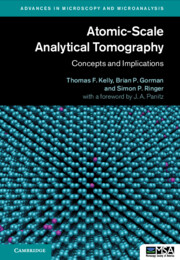Book contents
- Atomic-Scale Analytical Tomography
- Advances in Microscopy and Microanalysis
- Atomic-Scale Analytical Tomography
- Copyright page
- Dedication
- Contents
- Foreword
- Atomic-Scale Analytical Tomography (ASAT)
- Preface
- Acknowledgments
- Introductory Section
- Core Section
- Implications Section
- 10 The Nexus between ASAT and Density Functional Theory
- 11 Implications, Applications, and the Future of ASAT
- Index
- References
11 - Implications, Applications, and the Future of ASAT
from Implications Section
Published online by Cambridge University Press: 03 March 2022
- Atomic-Scale Analytical Tomography
- Advances in Microscopy and Microanalysis
- Atomic-Scale Analytical Tomography
- Copyright page
- Dedication
- Contents
- Foreword
- Atomic-Scale Analytical Tomography (ASAT)
- Preface
- Acknowledgments
- Introductory Section
- Core Section
- Implications Section
- 10 The Nexus between ASAT and Density Functional Theory
- 11 Implications, Applications, and the Future of ASAT
- Index
- References
Summary
We conclude our contribution with a prospective and optimistic look to the art of what might be possible with the advent of ASAT. We see a convergence between the digital or computational world and the experimental, and envisage ASAT as an enabler for the design and development of new materials. This potential arises because real-world 3D atomic-scale information will bring direct insights into thermodynamic, kinetic, and engineering properties. Moreover, when coupled with machine learning and other computational techniques, it may be envisaged that discovery-based procedures could follow that adjust the observed real-world atomistic configurations toward configurations that exhibit the desired engineering properties. This will fundamentally change the role of microscopy from a tool that provides inference to a materials behaviour to one that provides a quantitative assessment. This opens the pathway to atomic-scale materials informatics.
Keywords
- Type
- Chapter
- Information
- Atomic-Scale Analytical TomographyConcepts and Implications, pp. 222 - 235Publisher: Cambridge University PressPrint publication year: 2022

